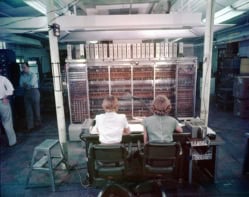Marco Delmastro reviews The Last Man Who Knew Everything by David N Schwarz

Enrico Fermi is a familiar figure for any physicist. His name is linked to so many phenomena, equations, techniques and even departmental buildings that it is simply impossible not to stumble upon the legacy of his work when you’re studying physics. For an Italian physicist, Fermi is even more than the Fermi statistics, or the Fermi constant, equation, level, energy, surface, velocity, golden rule (I could go on…). Long before having walked through the doors of a university physics department, Fermi’s name is familiar to students: in Italy there are high schools, streets, libraries named after this national hero.
Indeed, films have been made about the “Via Panisperna boys”, and more than one Italian-language biography exists. When I settled down to read The Last Man Who Knew Everything by David Schwartz, I was therefore asking myself whether there was really any need for yet another Fermi biography, and what a new book about him had to offer. While navigating the book, I realized that, despite being myself an Italian physicist, I maybe knew less than I thought about Fermi, and that there was still a lot I could learn.
The Last Man Who Knew Everything is an ambitious book. Schwartz is already very familiar with the community of nuclear and particle physics: while not a physicist himself, he is the son of the 1988 physics Nobel-prize winner Melvin Schwartz. He has therefore had plenty of opportunities, from his privileged position, to see how breakthroughs in physics actually occur. Despite this background knowledge, Schwartz set off on a quest across Europe in Fermi’s footsteps – from Rome to Pisa in Italy, to Germany, the UK, Switzerland and even the many US universities and labs where Fermi spent time – in order to write a true account of the scientist’s life and discover what it was like to work with him. The result is an informative and fun read, rich in those anecdotes and tales that always surround any scientific research, and that in this case help to elucidate what was driving the work of the giant that was Fermi.
The book is divided into four parts, each corresponding to a different phase of Fermi’s life: the formative years, which span his youth and his studies in Pisa; the Roman years, during which Fermi made his fundamental contributions to quantum mechanics and nuclear physics, culminating in his Nobel Prize; his first period in the US, spent between New York, Chicago and Los Alamos, and the quest for a self-sustaining nuclear pile and the atomic bomb; and the second American period, after the war. Despite the fact that each section is about the same length, they do not all equally succeed in providing an in-depth portrait of both Fermi the man and Fermi the scientist. This is in no way to be accounted to Schwartz: Fermi seems to have lived exclusively for physics, and he avoided (and even despised) talking about physics implications, or connections to philosophy and society. While many of his colleagues have left us their thoughts about the research they were developing and their interplay with society (think for instance of Heisenberg or Pauli, and their views on quantum mechanics; or of Feynman or Oppenheimer, and their recollections of development of the atomic bomb, or their more general point of view on science and society), Fermi’s personal thoughts on anything beyond his actual work are scarce.
Schwartz’s research into Fermi’s early years, as well as those years spent in Pisa and Rome, must have been frustrating. What did Fermi think of himself? How did he spend his time in Germany? What was his relationship with the Fascist regime? How did he react when he realized that the Nobel prize handed to him was actually for something he did not really achieve (the creation of new radioactive elements)? Did he realize or not what he had in his hands with his slow-neutron experiment (the fission of the atom)? Schwartz, much like Fermi’s previous biographers, is mostly left making educated guesses built upon inferences from second-hand testimonies.
On the other hand, things become clearer as soon as Fermi reaches the US (via Stockholm) after picking up his Nobel Prize in 1938. More people get to know him, at work and during private events. A picture of Fermi emerges and becomes more defined as we delve into his ambitions, drive and his unsurpassed capabilities. In this sense, The Last Man Who Knew Everything is very much an American book, and for me, the last two parts were far more satisfying that the initial two. One could think of this book as the perfect companion for the already existing “Italian” biographies of Fermi.
It is indeed particularly interesting to read about the hardships that Fermi and his family faced when they relocated to the US. Today, most researchers are “science nomads” by nature, but 75 years ago, moving to a new country was much more complicated. First of all, there was a language and communication issue: Fermi’s English was not good. He also struggled to get to grips with the cultural norms of the US in a world that was not only far from globalization, but also engaged in a global war. For much of this period, Fermi was considered an “alien enemy”, while simultaneously developing the atomic bomb for the US. This difficult position forced him to ensure his loyalty to the US government was never questioned. The more mundane aspects of Fermi’s life – his fears, vanities and human errors – emerge very well from these pages, and are in my opinion among the best contributions of the book.
Toward the end of the third part, Schwartz begins to address Fermi’s legacy. He starts by asking how much “the father of the nuclear age” can also be considered “the father of the atomic bomb”. While Fermi’s fundamental contributions to the understanding and taming of nuclear fission are undoubted, other scientists were probably more fundamental to the bomb development itself. This is also a sign of a general shift in how nuclear science was done before the Second World War, and what it would morph into after. The Manhattan Project is probably the first “big science” organization in history – such collaborations are extremely common today, especially in high-energy physics experiments, but very far from how Fermi used to (and preferred to) work. Fermi was exceptional in many respects, but his ability to simultaneously carry out complicated theoretical calculations, as well as delicate experimental work, is certainly what made him such a special scientist. High-energy physics has become a highly specialized field today, and the separation between theorists and experimentalists is greater than ever. It is very refreshing to read of a man who seems to have known nearly everything that was known at the time, who was able to do almost everything by himself, who devised a way to tackle arduous problems with simple and powerful tools, and was also a maestro at developing both theory and experiment at the same time. Fermi’s life and achievements not only awe us today, but also teach us a thing or two about science and the world at large.
- David N Schwartz The Last Man Who Knew Everything: the Life and Times of Enrico Fermi, Father of the Nuclear Age 2017 Basic Books 448pp £30/$35hb


